Exclusive Interview: Heat Winners Sky Arts Portrait Artist of the Year 2019
Posted by Cass Art on 31st Jan 2021
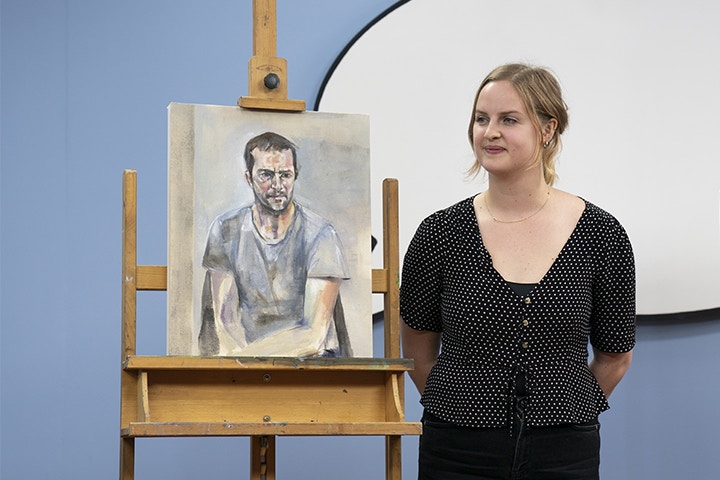
SARA LAVELLE
Congratulations on winning Heat 3 of Sky Arts Portrait Artist of the Year 2019! What was the experience like painting in front of the cameras, and capturing such a well-known face?
Before I applied to the show, I joked about how I could never do what the contestants do; painting in front of cameras and a live audience. I was used to painting on my own with no interruptions for days and endless tea breaks. I am shy and self conscious and so being in front of a camera is not my favourite thing. I am also shy about my work. My paintings always go through ugly phases and every time the camera zoomed in on my canvas at these points I wanted to knock them away!
I can honestly say that painting in the heats was the biggest challenge I have had in my painting career so far. I ended up having to zone out and get my head down and just see what happened. However, I think it was great for me to be so out of my comfort zone in that way. It made me grow in self confidence. I am incredibly grateful for getting this far.
It was also pretty incredible having such high profile sitters to paint. I keep seeing posters of James Purefoy’s face on the sides of busses and in TV series that I am watching and thinking, ‘I painted him!’
Judge Tai said that your work ‘took his breath away’ what was it like to watch back comments like his?
Tai is a huge inspiration of mine. I studied his work at school when I was doing my GCSE’s and was stunned that someone could paint like him. It is always nice to hear positive feedback but it is really special when that comes from someone you admire and value like I do Tai.
I have a tendency (as I am sure many artists do) to be a tad self deprecating. My art is the most important thing to me and what I have dedicated my life to. It is hard to always feel certain and confident about that. To have validation from the judges who are all important and knowledgable figures in the current art world was more than I could have hoped for.
There is a beautiful delicacy in your work, your light touch on the surface on the painting. Could you talk us through your process?
I began painting whilst doing my semester exchange in a university in America. I didn’t have any materials or much money whilst I was out there so I ended up thinning out the paints I bought with turps and linseed oil so that I could stretch them further. This is how I achieved the watercolour effect of the background of my self portrait.
I chose to paint peopled due to a deep fascination with human psychology and philosophy. At this time I particularly wanted to explore my own psychology through self portraits. Because of this I approached my paintings with delicacy and care so to tread carefully whilst handling such a raw and intimate subject matter.
In my work I hope to capture the fundamental essence of a person using soft colours and a gentle application of paint. I hope to achieve a stillness in my pieces that makes space for intimacy and contemplation between the viewer and the painted figure. I use pale pinks and blues and soft brushstrokes so that the weight of the subject matter is not swamped by the physical heaviness of the paint.
As a final year illustration BA student painting is a relatively new venture for you, do you have any particular paints or brands you’ve found that just seem to ‘fit’ your way of working?
I am mostly a self taught painter. I had to rebel against the structure of my illustration degree to be able to paint as much as I wanted to. This means that I am still exploring brands, materials and techniques.
I have recently been focusing a lot more on the type of canvas I am using. I have started buying unprimed canvas that I stretch myself, and then prime it using rabbit skin glue. I then apply my thin washes of paint mixed with turps and linseed oil which hold on the canvas allowing me to really push the water colour effect that I favour in my work.
I am experimenting with contrasting these washes with thicker areas of paint achieved using C Roberson Impasto Medium 120ml.
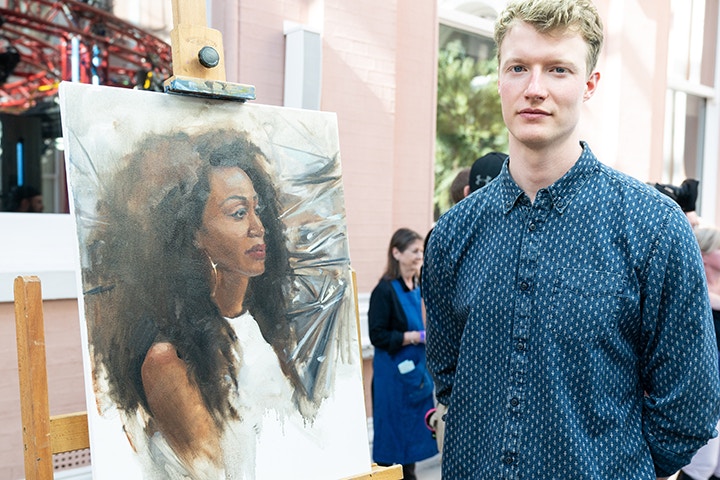
ARCHIE WARDLAW
Congratulations on winning Heat 4 of Sky Arts Portrait Artist of the Year 2019! What was the experience like painting in front of the cameras, and capturing such a well-known face?
Beverley was such a great model so I had lots to work with, she was very still when sitting which is a huge help when you only paint from life. A moving target makes an already difficult task much harder. The cameras were a bit of a distraction and sometimes got in the way but it was such a big occasion that everyone is too focused to be unsettled by them. Also the crew are so nice that you feel very comfortable.
During your heat you literally turned your painting on its head! Enabling you to look at it with ‘fresh eyes’ – do you have any more tips for our readers when they’re working through a painting?
It is so important to refresh your eye all the time. We have such a confirmation bias towards what we have already done that you have find different ways of seeing you work anew. I turn the painting upside down, take a photo on my phone or use a mirror to see the whole thing in reverse.
You trained for five years in the Classical Atelier method at London Fine Art studios, following in the footsteps of classical realist painters. How would you say this training has affected your approach to painting and painterly methodology?
The training I did was crucial to improving my eye for proportions. It also taught me about how to build a painting and how oil paint behaves; thin to thick, dark to light. All these can probably be developed through trial and error, but having some tuition saves years of needless mistakes. There is a fallacy of the artistic genius. No one produced great work straight away. The notion of genius also does a disservice to all the hard work that has been put in.
And does this training affect the materials/brands you choose to work with?
I was taught how to paint 'alla prima' which means wet on wet. This approach has made me very comfortable with oil paint that obviously takes longer to dry than other mediums. Often people are forced to stay with acrylic as they need the paint to dry before they build the next layer. I think oil paint has a much richer quality to it than acrylics which can be quite plastic like. Apart from that I try not to be too snobby about using the finest materials available. I use the most basic Rosemary and Co. brushes which are beautifully made and leave real texture to the brushstroke.
CATHERINE MACDIARMID
Congratulations on winning Heat 5 of Sky Arts Portrait Artist of the Year 2019! What was the experience like painting in front of the cameras, and capturing such a well-known face?
I was in a lucky position because I had been on the program before and knew what the structure of the day was going to be like. It is good to be aware of your own process of building a portrait as they wanted to record significant stages. You have to be open to scrutiny, which is not easy for artists, who are use to creating in isolation.
It is important, as with any portrait, to capture the likeness. Even more so with someone who is in the public eye, as everyone knows what they look like. So there is a certain amount of pressure in that respect, but I tried to not let it get on top of me as I didn’t want to compromise my own style of being an honest painter. I don’t tend to paint to flatter.
During the episode you said that Georgina’s eyes and mouth were just beautiful, when painting a sitters portrait do you tend to search for that distinct feature that holds your attention and build the work around that?
Georgina is stunning. So it would have been hard not to have a beautiful image at the end. To be honest I tend to look for light and shade in order to have some structure to build on. Mouths are generally the most difficult feature for me, but I found Georgina’s easy, because it was so distinctive. Hair can also give personality and I found that challenging with Georgina as she had tied it back.
The way you use light in your work is just fascinating, the sense of light in a painting, particularly on a face can be a challenge. Could you talk about your approach to capturing light in a work?
I generally start a painting with an under-colour and work in the tones, usually exaggerating them in the initial stages of a painting. It is almost like drawing. This can take a little longer so I adapted my style to suit the 4 hour time scale, and moved into the flesh colour quickly. But I love how light and shade bring out the structure of a face. Whether it is artificial or natural, light is the key to producing the illusion of 3D. Artificial light especially fascinates me and some themes in my own work are based on the abstracting effects of it. It was a challenge painting for the programme as the light was out of my control.
What materials are always close at hand when you’re working? And do you have any particular brands that you always turn to?
My preferred colour palette and painting mediums are always close by. I also love my soft blending brushes that can lift off excess paint and blend colours/tones together. I also have a good straight edge at hand, usually a piece of timber in my studio, but it was a T-ruler on Sky Portrait. I am not too fussed about brands but do like a good quality oil paint. Michael Harding (Magenta and Lemon Yellow are two of my favourite colour, and I would never be without Ultramarine Blue) or W&N Artists are oils I use. I never use black as you can mix a good black with good dark pigments. A good quality turpentine as well.
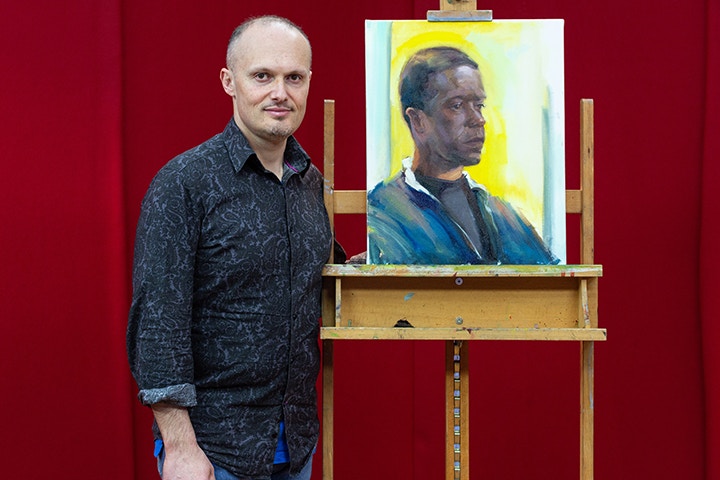
EMIL NIKOLLA
Congratulations on winning Heat 6 of Sky Arts Portrait Artist of the Year 2019! What was the experience like painting in front of the cameras, and capturing such a well-known face?
I would describe it as a real challenge as well as a great privilege due to the circumstances and the venue. Having cameras and people around was overwhelming to start with but after a few minutes, I switched into painting mode and blocked out anything other than Adrian. The focus then was on capturing the man behind the well-known face. In terms of colour, I started using warm tones on his shadowed side and ultramarine blue and viridian green hue on the lighter side to try to get the right colour balance. a mayor great difficulty was then to integrate the bright yellow background in the painting.
The judges loved your delicate colour palette, could you talk us through the use of colour in your work and your mixing process?
I think that there is not a particular pattern in the way I work with colour. I am always trying to get the right balance between warm and cool colours and I try to limit the use of white titanium as much as I can because it makes colours lose their luminosity. From there, intuition takes over and I find my way as I go along and work progresses.
Your palette is matched by your softness of touch with the brush – how do you approach your mark making? The judges described you as having ‘a bit of dance’ which I think mirrors the way that a brush dances across the surface of a painting.
I like to use flat brushes when I apply colour as they spread the colours evenly on the white surface of the canvas and I occasionally use my fingers to blend them. I do so partly because it helps me to physically immerse myself in the painting. In regards with the judges comment, it is interesting to hear that the judges described me as having a bit of a dance as I always think exactly that when I look at the work of one of my favourite painters, Giorgio Morandi.
Are there specific materials that you frequently turn to in your work? And if so, do you find that familiarity in medium allows for greater experimentations and expression in the physical act of painting?
I only use oil colours for my portraits because the spectrum of depth and light is greater than with other materials. Being familiar with a medium does definitely help with experimentation and expression.
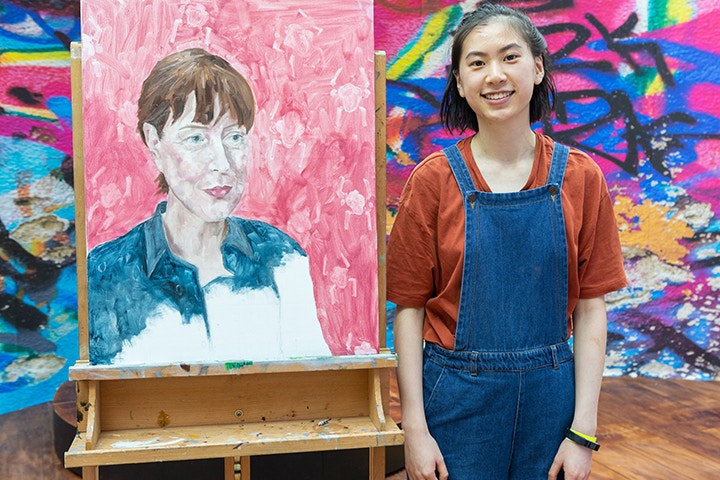
ANNABELLA LEE
Congratulations on winning Heat 7 of Sky Arts Portrait Artist of the Year 2019! What was the experience like painting in front of the cameras, and capturing such a well-known face?
The experience was incredible, overwhelming, and something I’ll never forget. Having cameras and the audience’s eyes on me constantly was an unimaginable amount of pressure, but it was just such a pleasure to talk to the judges about my work, as well as meet fellow artists. Rather than feeling intimidated by the fact I was painting someone so famous, I tried to just concentrate on the shapes and tones that make up a face, which made it a lot easier. I had to keep pinching myself though as a reminder that I was actually painting in the competition I’d been watching for years!
You spent an hour at the beginning of the session gridding out your surface and drawing details. Could you talk us through your painting process, do you always approach a new work with such initial precision?
Truthfully, I have never used the gridding method before - I got the idea from artists who used it in previous series. I really enjoy life drawing but with the time pressure and unusual conditions, I wanted to ensure I achieved a likeness quickly before applying paint. Although I wouldn’t normally use such a precise method, for the competition I did find it useful as I could still make the creative decisions in my head while drawing more technical details. However, I’d like to say my process maintains this acute observational quality regardless of the approach I take.
What is it about Oil that you love as a material, and do you have any particular favourites you enjoy working with?
My submission was the first time I had ever really used oil paint, and I just fell in love with it immediately. I am intrigued by the potential it has to create various atmospheres and moods, and how you can alter its properties, such as drying time, by using different painting mediums. Winsor & Newton have a great range of mediums - I like Sansodor low odour solvent as it is great for working indoors. In terms of paintbrushes, honestly I may have ‘permanently borrowed’ most of them from my school, but Pro Arte’s hog brushes are a firm favourite, because they make applying thick oil paint feel incredibly satisfying.
You are just at the start of your journey as an artist, and were only just about to sit you’re A-Level after your heat, I hope it went well! What have you been up to since, and what are your plans for the future?
My A-level exam felt like a breeze compared to the heat (though much less exciting)! I’m currently on an Art Foundation course at Central Saint Martins, where I’ve been able to further my interest in sculpture and installation, and is a really exciting learning experience. Next year I plan to study Fine Art at university, and after that I definitely want to do something art-related - but who knows what!
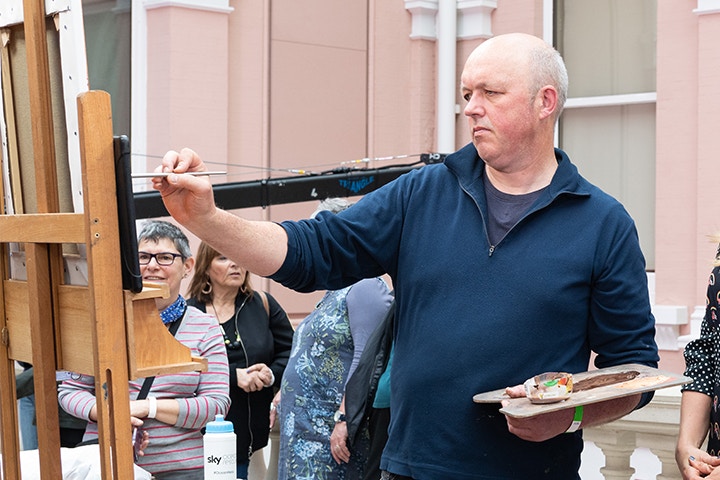
DUNCAN SHOOSMITH
Congratulations on winning Heat 8 of Sky Arts Portrait Artist of the Year 2019! What was the experience like painting in front of the cameras, and capturing such a well-known face?
Really didn’t mind the cameras, if someone asks me a question about my art then I’m more than happy to spout rubbish for hours. The hardest part was the noise in the room, the heat and glare from sunshine through the glass roof, and letting people see the early stages of a painting…the stages where you are still working things out, where parts are wrong, like reading the first draft of a book.
I wasn’t particularly worried about capturing a fantastic likeness; I was more concerned with producing a decent painting.
You really thought about the physical structure of Jodie’s face, going beyond the surface and considering the bones that sit beneath the surface. Is this ‘inside-out’ way of thinking essential to a successful portrait?
Personally, yes, it is a key element. We know there is a skull behind every face, and that particular skull will determine the particular form and tone of that particular person. A bit of anatomical knowledge can’t hurt.
This physicality showed through in the way that the judges described your portrait as almost sculptural, a quality further achieved from your use of the paint on the surface. Could you talk about paint application?
The brushstrokes help to define the form. I want a surface to interest me more than polished photorealism. I want a surface that shows the intent of its application.
What materials are always close at hand when you’re working? And do you have any particular brands that you always turn to?
I use paint quite liberally so tend to buy large tubes of ‘budget’ paint like Daler-Rowney Georgian or Lukas Studio, however; some of their paints have too little pigment in, so for Burnt Umber and Paynes Grey I use more expensive brands like Old Holland and Michael Harding. I used to use Cremnitz and Flake whites but they have now been banned. I use simple Pro Arte synthetic long flat brushes, nothing fancy, I’m a firm believer in not letting your materials make excuses for you.
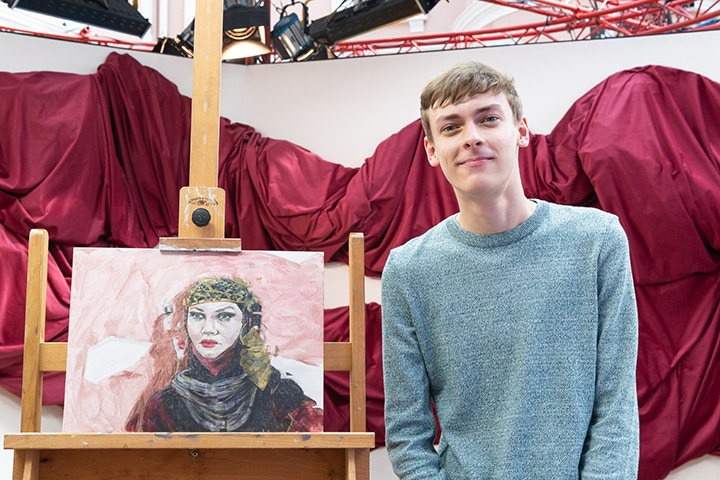
TOM MEAD
Congratulations on winning Heat 8 of Sky Arts Portrait Artist of the Year 2019! What was the experience like painting in front of the cameras, and capturing such a well-known face?
Thank you! I had tried to prepare for the show as much as possible, although I definitely wasn’t prepared for a sitter like Daniel Lismore. Trying to capture a likeness under the makeup was a challenge, and I spent longer doing the drawing than planned to make sure all the features were in the right place. Thankfully he was an incredible sitter and barely moved. I was also very unprepared for the amount of interviews I’d need to do, which makes the 4 hours fly by, but the feedback you get along the way really helps motivate you.
You use a very interesting ‘fragmentation’ technique in your paintings. Taking aspects of the face or background and repeating it. How did you come to this visual style, and how does it affect your approach to a painting?
There are a few Art movements and artists that have inspired my style, and I’m still developing my own techniques. Overall, I just want to capture more than a single photo could do. Hopefully my work gives more of a sense of time and life, and seeing more than one angle of a face helps capture a stronger likeness of the sitter. The idea of merging traditional painting with technology in the form of a ‘glitch’ effect is also very interesting to me, and I prefer to not know what my finished painting will look like when I begin painting it.
You also take a lot of inspiration from film, working with that ‘16:9’ format and the suggestion of movement. What is it about film that inspires you in your work?
I think just growing up with films as opposed to paintings has made me see my work as (very) short films. The concept of visualising a length of time has made me think in terms of cinematography instead of composition. If my work can capture more of a scene with a developing narrative I’m very pleased. In my studio work I love to feel like a director, letting the lighting, scenery and movement add to an atmosphere or character study in the painting.
If I delved in your studio what materials would I find? Are there any brands that you always return to?
My studio is full of acrylic paint. I really water it down so I’m more than happy to buy cheaper brands, but for stronger colours I’ll use liquitex (cobalt teal and parchment are amazing colours) or system3 paint. I started using flat brushes about 3 years ago and was amazed at how much they improved my work. ProArte Masterstroke brushes are my favourite.
CALL FOR ENTRIES
Feeling Inspired?
Dust off those paintbrushes and wipe off those palettes and get painting! If you need to top up your materials before you get going you can shop with us in-store or online, we have everything you need.
Image credits: Photography © Sky Arts, paintings © StoryVault.


